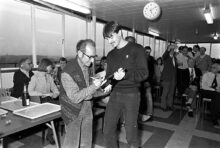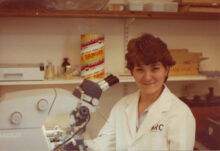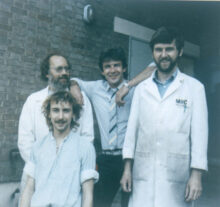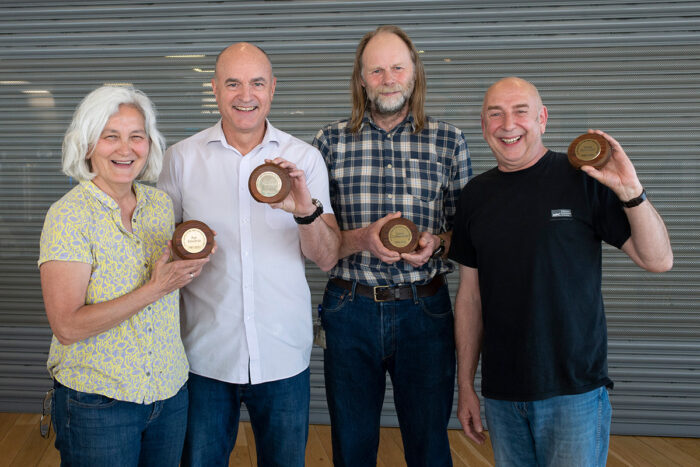
The LMB is thrilled to honour four members of staff who have each reached 40 years of service. David Cattermole, Paul Hart, Pat Edwards and Steve Scotcher are all valued members of the lab, with a wealth of varied experience and knowledge.
David Cattermole
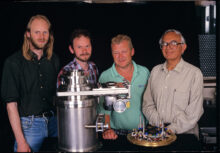
Senior Design Engineer in the Electronics Workshop, David Cattermole has been at the LMB since February 1982. He joined the workshop as an Electronics Technician, working on developing radio frequency heating and temperature monitoring equipment.
Whilst working at the LMB, David earned a postgraduate diploma in computing, allowing him to adapt to the rapid increase in computer involvement. Now, most of his projects involve writing software, either embedded within the equipment being developed, or to interface equipment control and data collection.
As well as increased computerisation, David’s time in the Electronics Workshop has also seen the size of components shrink. Now, he often needs to use a microscope for assembly.
On what’s kept him at the LMB for 40 years, David shared, “One of the best things about working at the LMB has been the variety of projects we get involved with. I’ve worked on sensing mouse activity, recording photo-multiplier data, film scanners, CCD (charge-coupled device) imaging, and more.”
Paul Hart
In February 1982 Paul Hart joined the LMB as a junior instrument service engineer. He quickly learnt how to repair most of the scientific equipment at the LMB, and when computers began to arrive in the mid-1980s, Paul was put in charge of setting them up, making them work, and fixing them when they went wrong.
As computers evolved, so did Paul’s role at the LMB. Today he is Head of the IT Department. Over the last 40 years, Paul has spearheaded several huge and vital projects; from designing the IT system for the new LMB building and facilitating the mass shift to work from home during the COVID-19 pandemic.
Away from IT, Paul has also been involved in lots of LMB events and gatherings throughout the last four decades. Since 1982 he’s been involved in every Christmas party, from manning the door to electronic sound mixing for the house band. In the warmer months, Paul also takes on manning the annual summer barbecue to everyone’s delight.
Read Paul’s account of his career and the development of IT at the LMB here.
Pat Edwards
Pat Edwards joined the LMB in November 1981 as a research technician working on muscle structure with Murray Stewart and Hugh Huxley. Specifically, she purified protein from native muscles and conducted negative strain and shadow preparations on isolated rod fragments for electron microscopy (EM) for Murray. For Hugh, Pat prepared muscle tissue in epoxy resin blocks and made thin sections for EM ultramicroscopy.
In the last 40 years, Pat has worked on numerous cutting-edge research projects. Her skills at picking crystals of rhodopsin under dim red light assisted Gebhard Schertler in determining one of the first structures of a GPCR. She also picked the crystals for the first structure of the beta1 receptor.
Now, Pat is a Research Support and Lab Manager in Chris Tate’s group, where she assists in protein expression and purification and looks after the mammalian tissue culture lab, growing both mammalian and baculovirus cell lines. Pat is also an active member of the LMB Green Committee, who are dedicated to finding and implementing new ways to make the lab more sustainable.
Reflecting on her career at the LMB, Pat said, “I’ve been lucky to meet folks from all around the world and made long-term friends who I’m still in touch with all these years later. The collaborative air in the building makes for such a relaxed attitude – you can go to anyone, whatever level, for help and advice or just a friendly chat. Also, through all the collaborations I have been involved in, I have my name on papers with six Nobel Prize winners! César’ Milstein, Aaron Klug, John Walker, Venki Ramakrishnan, Richard Henderson and Brian Kobilka. They weren’t all prize winners at the time, but were later after our papers!”
Steve Scotcher
Steve Scotcher joined the LMB in April 1982, initially as a cleaner and handyman in the Maintenance Department. After completing an apprenticeship qualification, he joined the Technical Instrumentation Workshop (often called the Mechanical Workshop), initially as an Engineering Trainee and then progressing to be a Junior Technician. In the 1980s, Steve spent a lot of time making gel boxes; mini gel boxes, horizontal and vertical gel boxes, liquid and air-cooled gel boxes and a variety of prototype gel boxes.
More experience and increased computerisation of machines allowed Steve to go on to build more and more technical equipment, including a fine focus, rotating anode, X-ray generator, designed for use on the International Space Station.
Today Steve is the Head of the Technical Instrumentation Workshop – a position he’s held since September 2010. Aside from managing the workshop, he’s actively involved across other aspects of LMB life such as participating in Christmas skits, and in public engagement activities, including Royal Society Summer Exhibitions.
Read more about Steve’s career and his reflections on how the workshop has evolved over the last 40 years here.
Further references
Behind the scenes: Paul Hart and the development of IT at the LMB
Behind the scenes… with Steve Scotcher
